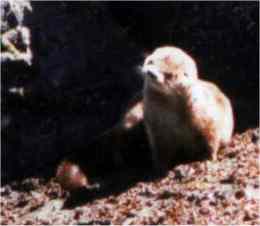Reproduction in the Marine Otter
The information below comes from Cabello in IUCN:Otters (1977), Larivière (1998) and the World Wildlife Fund.
The lifecycle of this species is not well understood, and there is disagreement between different observers. The consensus seems to be as given below, at present, though further observations are needed.
The Marine Otter appears to be monogamous, although Larivièere says that if there is plenty of prey and a high otter density, polygamy can occur. The females come into oestrus in December and January (Summer in the Southern Hemisphere), and according to Cabello, mating goes on for more than 40 minutes.
 The cubs are born from January to March, in cave-dens, or depressions
between rocks and dense coastal vegetation. Usually 2 cubs are born, though in
the Magellanes, 4 or 5 have been observed. If cubs are lost, Cabello found no
evidence of a second mating and birth until the next summer.
The cubs are born from January to March, in cave-dens, or depressions
between rocks and dense coastal vegetation. Usually 2 cubs are born, though in
the Magellanes, 4 or 5 have been observed. If cubs are lost, Cabello found no
evidence of a second mating and birth until the next summer.
The cubs remain with their parents for around 10 months. Both parents bring food to the cubs and teach them to hunt. When moving the cubs, the parents carry them in their mouths, or swim on their backs with the cubs resting on their bellies.
The life expectancy of this species is unknown.
| Marine Otter |

